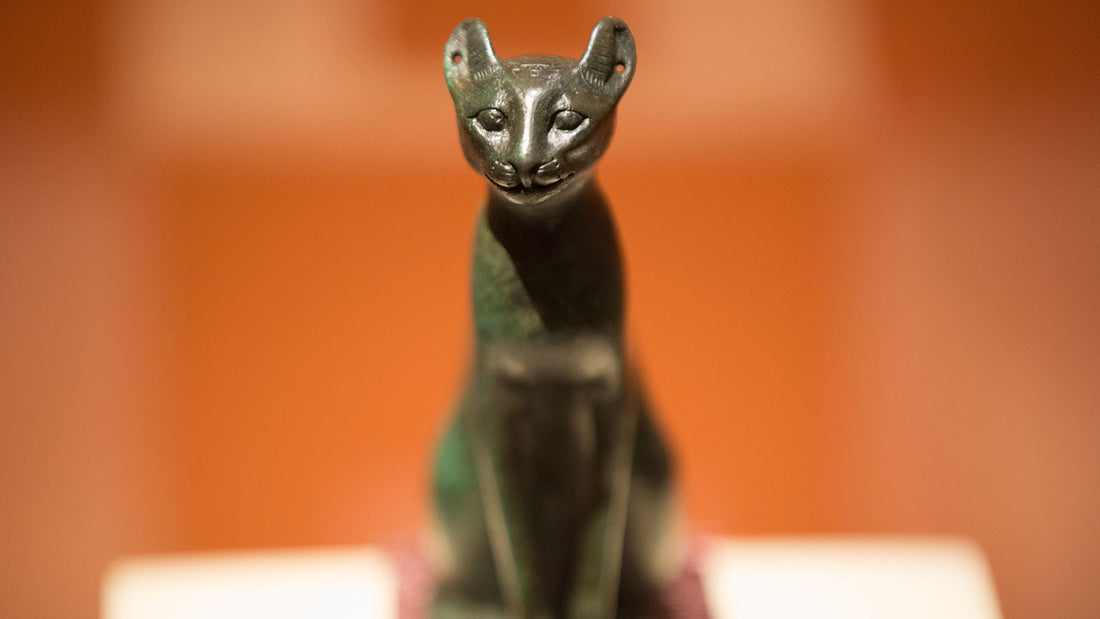I have an Instagram page, named Cats Being Comical, on which I regularly post funny cat memes. One particular meme that I have posted is of an image depicting a cat with a dagger cutting through a snake, and it is taken from an Egyptian hieroglyph. I captioned this meme, “Ancient Egyptian cat meme; proof that the cat meme predates the internet.” Hieroglyphs were the formal writing system used in Ancient Egypt, comprising of a stylized picture of an object representing a word, syllable, or sound.
Looking at that picture of a cat stabbing a snake, I wanted to know what it meant, (that’s if it meant anything at all, of course.) I learnt that the cat in the picture represented the power of the Gods cutting through Apopis, the snake deity who threatens Ra (the sun) at night in the underworld. I was intrigued, and wanted to know more.
Cats In Everyday Life.
Whether it’s art, fashion or home ornamentation, images of cats could be found everywhere in ancient Egypt. However, when I researched their belief about certain Gods, I realized that it’s a common misconception that this ancient civilization believed that the various animals were idolized as Gods themselves; instead they were vessels that the Gods chose to inhabit. Julia Troche, an Egyptologist & assistant professor of history at Missouri State University says, “Though it is hard to say the Egyptians thought one thing or another, since so much change happened across their 3,000+ years of history, the ancient Egyptians, in general, did not worship animals. Rather, they saw animals as representations of divine aspects of their gods.”
A Mutually Beneficial Partnership.
Venomous snakes, stinging scorpions and greedy grain-eating rats were a very big problem for Egyptian households, and cats were the perfect predator to eliminate these threats to everyday life. Imagine being a parent with a young toddler crawling about with venomous snakes being an ever present danger to them, and it doesn’t take much to figure out why our fantastic felines who chased them away were so valued and respected. It’s no wonder that the marvelous moggy was an integral part of their life, revered as a magical creature that brought good fortune to those that housed them. Oh, and let’s not forget that they’re not only useful, they make great companions too!
Did Ancient Egyptians Believe That Cats Were Gods?
The ancient Egyptians believed that their gods could assume different forms, and over the centuries, it became increasingly common for gods to take the form of animals, including cats. I became interested in which Gods were shown with either a cat-like head or body, and these are:
- Mafdet
- Bastet
- Sekhmet
- Mut
The best known of the above-mentioned is Bastet, a feline Goddess and daughter of the gods Ra & Isis. She was originally represented as a fearsome lioness, but is later depicted as a domestic cat, protector & nurturer of the family.
Mafdet was a Goddess who protected against scorpions & snakes, and assumed the form of either a feline or mongoose.
Mut translates as “mother” and was the deity associated with water, which was the source of life itself. She is depicted holding the ankh, the Egyptian symbol of life, and usually wears a double crown of the Pharaohs on her head. The crown represents her control over Egypt’s lands. Mut has taken various forms, such as a cat, a cow or a lioness, and even a vulture or a cobra.
Sekhmet, meaning “the mighty,” is the warrior goddess and goddess of healing who guided & protected Pharaohs in warfare. Professor Toche says, “Sekhmet was a lioness goddess who was a warrior and protector deity who kept at bay the enemies of the sun god Ra and who also kept away illness and sickness. In this way, we can see that the ancient Egyptians thought of cats, more generally, as protectors, while at the same time they respected their ferocity.”
As well as being useful pest controllers, there’s another power that cats were believed to possess. In art they’re often connected to scenes of women, sitting under their chairs, for example. Perhaps this superstition arose from the fact that cats have multiple kittens in a litter, but they were thought to bring fertility.
The Afterlife.
Scenes from everyday life decorate the walls of the tombs. As Professor Toche explains, “The tomb was one's posthumous house for eternity. In your tombs you would depict your family, your greatest titles and awards and the things you enjoyed doing. So, to see cats included in these tableaus speaks to their importance both in the daily lives of ancient Egyptians and in their hope that they continued with them into the Hereafter.”
Well, we’re all familiar with the iconic image of the ancient Egyptian mummy, but did you know that cats were also mummified? The belief was that in the afterlife the deceased could inhabit the mummified cat’s body.
Sacrificed To The Gods.
Since deities would often appear with the head of a cat & could also inhabit their bodies, these animals were a popular offering to the Gods and were farmed for this specific purpose on a large scale. In fact, it was forbidden to kill cats in ancient Egypt for any reason except one: mummification. There are many mummified moggies to be found in the pyramids.
Royalty Made Cats Fashionable.
The Pharaoh’s kept giant cats, and would dress them in gold, letting them eat from their plates. The feline’s favored status with Kings influenced the populace, & jewelry with pussycat designs were commonplace in antiquity.
Final Thought.
Owing to the preferences of deities & Pharaoh’s, cats were held in high regard in ancient Egypt. They were a reminder of the power of the Gods & an invaluable part of day-to-day life, just as they are today!
Want to know more? If you are interested in learning some more about Bastet, then watch this fascinating video!

